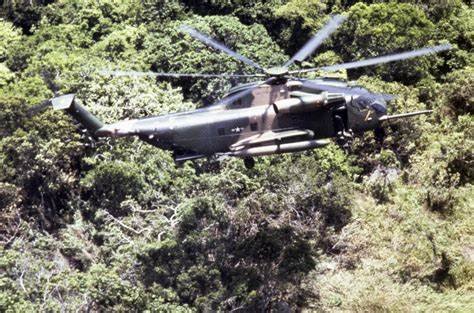“That Others May Live”: The Heroic Last Flight of Jolly Green 67
On April 6, 1972, HH-53 helicopter Jolly Green 67 was shot down while attempting to rescue American airmen during the legendary Bat 21 mission—one of the largest and most dangerous rescue operations of the Vietnam War.
April 6, 2025

In the final years of the Vietnam War, as the North Vietnamese launched their largest offensive yet—the Easter Offensive of 1972—one of the most harrowing and heroic stories of the conflict unfolded in the skies over South Vietnam and Laos. At the center of that story was an HH-53 Super Jolly Green Giant rescue helicopter with the tail number 68-10365, known by its call sign: Jolly Green 67.
Assigned to the 37th Aerospace Rescue and Recovery Squadron (ARRS) and operating out of Da Nang Air Base, Jolly Green 67 and its crew were part of the elite U.S. Air Force rescue forces whose motto—“That Others May Live”—was more than just words; it was a mission they lived and died by.
The Mission: Bat 21
On April 2, 1972, an EB-66 electronic warfare aircraft, call sign Bat 21, was shot down by a North Vietnamese surface-to-air missile as it escorted B-52 bombers targeting advancing enemy forces. Only one crewmember survived: Lt. Col. Iceal “Gene” Hambleton, who managed to eject behind enemy lines. His call sign during the rescue was Bat 21 Bravo.
As Hambleton evaded capture, the U.S. launched what would become the largest rescue operation of the war. The efforts spanned nearly two weeks, involved over 800 airstrikes, and included the loss of multiple aircraft and crews. The mission would ultimately become legendary—but not without tragic cost.
The Final Flight of Jolly Green 67

On April 6, after multiple failed attempts by Army helicopters and Air Force rescue teams to reach Lt. Col. Hambleton and another downed airman, a major new effort was launched. The skies had finally cleared after days of bad weather, and 42 preparatory airstrikes were flown to suppress enemy defenses.
Jolly Green 67 was selected to make the rescue attempt, supported by six A-1 Skyraider “Sandy” escort aircraft, forward air controllers in OV-10s and O-2s, and a host of supporting air assets.
- As the helicopter approached a hover above Bat 21 Bravo, it came under intense enemy fire. Despite the A-1 escorts engaging enemy positions, they could not neutralize all of the gunfire. Radio chatter from the Sandy pilots captured the growing alarm: the helicopter was being torn apart midair. The crew aborted the rescue and attempted to escape—but the damage was too severe. Jolly Green 67 crashed in a massive fireball just kilometers from the downed airmen it was trying to save.
There were no survivors. The blaze from the crash site burned for days and the remains of the crew were not immediately recovered.

Captain Peter H. Chapman, pilot
Captain John H. Call, co-pilot
Technical Sergeant Allen J. Avery, pararescueman
Technical Sergeant Roy D. Prater, pararescueman
Sergeant William R. Pearson, flight engineer
Sergeant James H. Alley, combat cameraman (601st Photo Flight)
During the Vietnam War, the U.S. Air Force's "Jolly Green" helicopters—primarily the HH-3E "Jolly Green Giant" and the HH-53 "Super Jolly Green Giant"—were integral to Combat Search and Rescue (CSAR) missions, bravely venturing into hostile territories to retrieve downed airmen. Their valorous efforts, however, came at a significant cost.
HH-3E "Jolly Green Giant" Losses:
-
Total Losses: 34 aircraft
-
Combat Losses: 25
-
First Combat Loss: CH-3E 63-9685 (38th ARRS) was downed by anti-aircraft artillery over North Vietnam on November 6, 1965. Three crew members were captured, and one was rescued.
-
HH-53 "Super Jolly Green Giant" Losses:
-
Total Losses: 27 aircraft
-
Combat Losses: 17
-
First Combat Loss: HH-53B 66-14430 (40th ARRS) was hit by ground fire during a CSAR mission in Laos on January 18, 1969. The crew and the rescued A-1 pilot were safely extracted by another helicopter, and the downed HH-53B was subsequently destroyed to prevent enemy capture.
-
These figures underscore the perilous nature of CSAR operations during the conflict. The crews of the Jolly Green helicopters exhibited extraordinary courage and dedication, often flying into heavily defended areas under intense enemy fire to save their fellow service members. Their sacrifices significantly contributed to the U.S. military's rescue efforts in Southeast Asia, embodying the CSAR motto: "That Others May Live."

-
